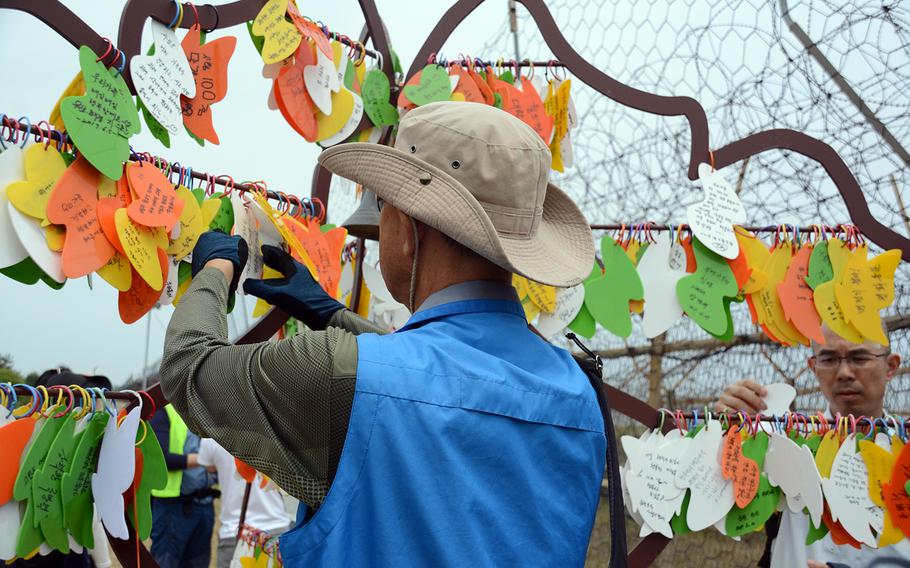
South Koreans place wishes for peace on a tree of hope erected on the Goseong DMZ Peace Trail, which was recently opened to civilians in the northeastern part of the heavily fortified border area. About 20 South Koreans participated in a hike on Friday, June 14, 2019. (Kim Gamel/Stars and Stripes)
GOSEONG, South Korea — The craggy mountains, glistening lakes and white sand lining the coast of North Korea are still out of reach.
However, many South Koreans have enjoyed a closer view since the government opened a civilian hiking trail in April in a northeastern section of the Demilitarized Zone, a heavily fortified strip of land that divides the peninsula.
The so-called DMZ peace trail is a signature part of President Moon Jae-in’s efforts to transform the buffer zone, which has largely been a no man’s land since the 1950-53 Korean War, into a symbol of unity despite stalled talks with the communist state over its nuclear weapons program.
“In the past we couldn’t get anywhere near North Korea,” Lee Jeehyun said Friday as she and her husband joined one of the more than hourlong walking tours. “But today I feel that reunification is closer than ever. It makes me feel all aflutter.”
The U.S.-led United Nations Command, which oversees activities in the DMZ, has approved plans for three trails in the DMZ.
So far, only the one in Goseong, which sits in the section that snakes north of the 38th parallel and features a view of North Korea’s famous Mount Kumgang, has begun accepting visitors.
Groups of about 20 tourists at a time, escorted by soldiers, walk along a coastal path marked by two rows of tall barbed wire fences cutting off the beach. Signs warn of land mines on the other side.
On Friday, the guide Park Jeung Hey rattled off the names of trees and flowers and historical tidbits. Her charges were delighted when a deer appeared nearby before retreating into the trees.
Park noted abandoned railroad tracks along the route. “You might imagine that you might use this road and the railway to visit Mount Kumgang in the near future,” she said.
She later pointed to a tree-covered hill off the coast, saying the abalone and blue mussels in the surrounding waters have thrived because the area has been free from fishermen.
“That island is really a paradise,” she said.
Security concerns remain high and photos are only permitted only at certain points, including the wreckage of a mangled forklift that was destroyed by a land mine in 2003. The driver miraculously survived, the guide explained.
Tourists also are invited to hang messages written on green, yellow, orange and white plastic cards on a sculpture dubbed a tree of hope. “I wish my one step could become a step for peace,” said one. Another expressed hope for peaceful unification.
The DMZ, which is about 2 ½ miles wide and 155 miles long, has been largely inaccessible to civilians since the war ended in an armistice instead of a peace treaty.
Most South Koreans and foreigners could visit it only via tightly controlled tours to the truce village of Panmunjom, also known as the Joint Security Area, about 35 miles north of Seoul.
Moon and North Korean leader Kim Jong Un agreed to turn the area into a “peace zone,” among other goodwill initiatives during a series of summits last year.
The North has been giving Seoul the cold shoulder in recent months, a side effect of stalled nuclear talks with the United States. But the South Koreans have pressed forward on their side of the border, albeit with a limited scope.
The trail consists of two courses — one by foot and the other by vehicle — and ends at a barricaded gate that has been used in the past by travelers to North Korea’s famous Mount Kumgang for reunions of families who had been separated by the war.
A sign declared it to be the northernmost point of South Korea.
Lee Saet-Byeol of the Goseong district office said more than 4,300 people have participated in the tours since they began on April 27, coinciding with the first anniversary of the first summit between Moon and Kim.
Participants must apply via a website — www.dmzwalk.com — and are selected by lottery for the tours, which are conducted twice a day, every day except Monday.
For now, officials said the Goseong tours are limited to South Koreans, with some exceptions, including foreign reporters invited by the government to join the group on Friday.
Park Jangsoon, a 52-year-old businessman from Suwon who brought his wife and 11-year-old daughter on the tour, reminisced about his days on the frontlines with North Korea during his mandatory military service when he was younger.
Park said he’s skeptical about Moon’s peace efforts, noting past South Korean administrations also engaged in talks with the North Koreans only to see them fail.
“I believe the government should pursue policies that will carry over to the next generation,” he said. “It looks to me like Moon’s policies are the same as those in the past.”
Lee and her husband, Chung Eunyoung, said it’s important to build trust with the North Koreans.
“I feel very lucky to come here today. It’s a once-in-a-lifetime opportunity,” she said. “I wish more people could visit here. This is a place that South Koreans have in their minds.”
gamel.kim@stripes.com Twitter: @kimgamel